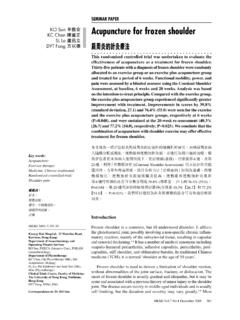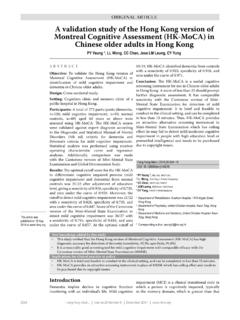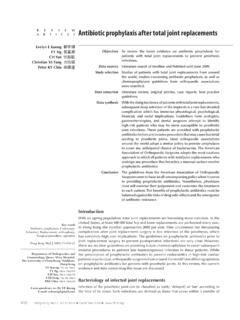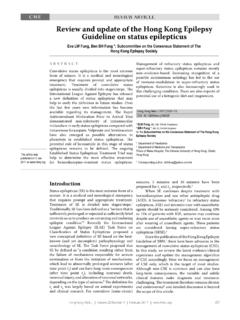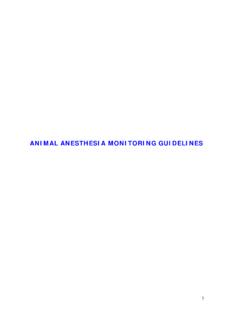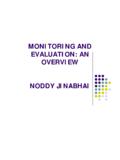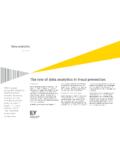Transcription of The monoplace hyperbaric chamber and …
1 HKMJ Vol 7 No 4 December 2001 435 CASE REPORTKey words:Decompression sickness;Diving;Emergency treatment; hyperbaric oxygenation ! ! !" !"The monoplace hyperbaric chamberand management of decompressionillnessThree cases of decompression illness are reported. Two patientspresented with joint pain and skin signs, while one patient presentedwith joint pain and neurological signs and symptoms. The patientsreceived emergency recompression therapy in a Hong Kong clinic,using a monoplace hyperbaric chamber . All three patients weretreated successfully and no residual signs or symptoms were evidenton review at 90 days post-treatment. Issues concerning the use ofmonoplace and multiplace hyperbaric chambers are also discussed,along with additional clinical applications of the monoplace hyper-baric chamber . !"#$%&'(')*+, :;. !"#$%&'()"*+, 01234546789 !"#$%&' ()*+, *()190 !"#$ !
2 "#$%&'()*+, : !"#$%&'()*+, RCT Li HKMJ 2001;7:435-8 !"#$%&!'()*Asia hyperbaric Center, AML, 28A ShumWan Road, Wong Chuk Hang, Hong KongRCT Li, DFM, DOMC orrespondence to: Dr RCT LiIntroductionDecompression illness is not a common occupational disease. However,it can occur in recreational scuba divers, commercial divers, and otherworkers using compressed air. The pathogenesis of decompression illnessrelates to residual nitrogen and bubble formation. The formation of abubble, however, is only the first of a sequence of events that, dependingon their location, may have no symptoms or may result in conditions thatrange in severity from skin rash and pruritus, to convulsions and monoplace hyperbaric chamber is designed to treat a single patientin one session, while the operators observe and maintain communicationvia a transparent acrylic tube and intercom.
3 Due to the shortage ofknowledge1 and the limited availability of clinical hyperbaric chambers,the development of hyperbaric oxygen therapy is still in its infancy inHong All three cases in this report were managed in a privateclinical hyperbaric centre, which has been in operation since April reportThree local Chinese men, in-shore commercial divers aged between 35and 38 years, presented with symptoms including joint pain, skin rash,and neurological complaints, after diving work on a local constructionproject. The diving characteristics, history, and presenting features of eachpatient are summarised in the HKMJ Vol 7 No 4 December 2001 LiTreatment methodBefore admittance to the hyperbaric chamber , all casesunderwent a brief physical examination, includingassessment of mentation, coordination, cranial nerves,deep tendon reflexes, muscle strength, breathing,pulse, and blood pressure.
4 Two of the patients presentedwith joint pain and skin rash only. They receivedtherapy at ATA with pure oxygen, according to theJP Le P chon One patient presented withpersistent headache, nausea, and right shoulder received therapy at ATA with pure oxygen,based on the Hart monoplace treatment desired treatment pressure was achieved within9 minutes in two patients, while 15 minutes wasrequired to achieve the desired treatment pressure inone patient, due to left ear equalisation two patients with joint pain and skin rash only,responded well within the first 25/5 minute oxygen/air treatment cycle. Thus, the treatment was completedwithin the specified timeframe, without the need forextension. An extension of 25 minutes oxygen and 5minutes air cycle at ATA was required for thepatient with nausea and persistent headache, how-ever, before complete resolution of symptoms.
5 Slowdecompression over 30 minutes followed treatment,with the divers monitored for any residual clinicalsigns and symptoms. Patient review the followingday and at subsequent 3-monthly intervals found noevidence of residual signs and symptoms over a 90-day of chamberIt is clear that a walk-in , multiplace chamber offersseveral advantages over a monoplace chamber . Thereare more options regarding choice of pressure andtreatment gas, for example, and it is also possible toconduct a neurological examination throughout thetreatment process. The use of a monoplace hyperbaricchamber for the treatment of decompression illnessand air embolism has been controversial in the original design of the monoplace chamber utilised100% oxygen. Almost universally, these chamberswere limited to a three-atmosphere ( m) pressurecapability. Standard US Navy recompression tables5stipulate breathing air at several intervals to reduceoxygen toxicity.
6 Nowadays, some monoplace cham-bers are pressurised with air but also equipped with abuilt-in breathing system, using a tight-fitting demandmask to deliver oxygen and other modifications (Fig).This allows US Navy recompression tables used withmultiplace chambers to be followed when therapy isprovided using a monoplace majority of non-critically ill patients treatedin a monoplace chamber can be monitored safely bydirect observation alone. Respiratory rate is evident,as well as manifestations of anxiety, which can bea warning sign of central nervous system oxygentoxicity. Critically ill patients, however, requireadditional monitoring . This includes equipment formaintenance of an artificial airway, ventilators, haemo-dynamic monitors, a defibrillator, suction apparatus,oximeters, intravenous catheters, and in some caseschest drainage tubes. With the development of elec-trical, intravenous and gas portals, modern clinicalmonoplace chambers can allow electrocardiography,Table.
7 Characteristics of decompression illness (n=3)Diving characteristicsWorking depth andTime at maximumPossibledecompression tabledepth (mins)predisposing factorsAll dives using Surface Supplied165 fsw/USN 170 fsw18 Repetitive diveAir Diving EquipmentsAir decompression tableLimited training and experience in in-shore172 fsw/USN 180 fsw22 Repetitive diveand civil divingAir decompression table192 fsw/USN 200 fsw15 Repetitive diveAir decompression tableFig. monoplace hyperbaric chamber with built-inbreathing systemHKMJ Vol 7 No 4 December 2001 437 The monoplace hyperbaric chamberblood pressure monitoring , intravenous infusion, andassisted ventilation if necessary. Critically ill patientscan thus be managed, providing the facility is staffedwith nurses, therapists, and physicians skilled in themanagement of the critically ill patient, as well aspossessing a thorough understanding of hyperbaricphysiology and the medical techniques unique tohyperbaric oxygen common query with regard to decompressiontherapy is whether one should transport a patientto a distant multiplace chamber for treatment, orprovide recompression therapy immediately in alocal monoplace A recent review completedby the Divers Alert Network compiled the 90-dayoutcomes for patients treated in monoplace chamberscompared with those treated in multiplace patients with pain only or categorised as Type I ,7residual symptoms were seen in of patientstreated in multiplace units.
8 And in of patientsreceiving treatment in monoplace hyperbaric figures were and for multiplaceand monoplace chambers, respectively in patientscategorised as mild Type II cases, and , respectively for patients with severe Type II These good comparative results mayreflect early referral to monoplace chambers, or thelack of more aggressive treatment in multiplacehyperbaric units, however. In Hong Kong, currentlythere is only one multiplace recompression chamber ,which is located on a remote island. Emergency recom-pression treatment using this multiplace chambertherefore requires:(1) Accident and Emergency Department consult-ation;(2) a confirmed diagnosis of decompression illness;(3) contact with the Fire Service Department byphone;(4) transportation of the patient by ambulance to theisland; and(5) mobilisation of the doctor on-call at the LabourDepartment for a treatment , several hours of delay before treatment iscommon in Hong Kong when the multiplace hyperbaricchamber is selected for use.
9 A well-equipped treatmentcentre using a monoplace hyperbaric chamber incontrast can deliver hyperbaric oxygen therapy within1 hour of of treatment tableAssuming one has a two-compartment multiplacehyperbaric chamber , with full pressure capability andmixed gas as well as oxygen available on the manifold,one can select the US Navy Standard treatment protocolbased on the clinical condition. In patients presentingwith joint pain only, as seen in two of the current pa-tients, rapid resolution of signs and symptoms can beexpected with use of oxygen as recommended in theJP Le P chon table. Total intervention recommended hours at ATA, with four 25/5 oxygen/air cyclesto achieve the best result and reduce oxygen practical limitation of the monoplace chamber isa maximum working pressure of 3 ATA. Thus,obtaining a treatment pressure of ATA ( poundsper square inch gauge pressure) as recommended intable 6 of the Standard US Navy recompression tablesis a Use of the Hart monoplace chambertreatment protocol at 3 ATA is therefore preferable indecompression illness associated with neurologicalsymptoms.
10 Current data indicate the Hart monoplacetreatment protocol is well within safety margins forpotential oxygen for prompt treatmentClinical experience of decompression illness andtherapy suggests that delays in treatment render therapyless effective, regardless of type. It is also probablethat longer treatment tables yield better results in casesof severe decompression illness. Current data indicatethat it is preferable to use a monoplace chamber , evenwith a short treatment table, if it is close at hand, ratherthan to delay treatment while a multiplace chamberfacility is reached, of onset of signsPresenting signs and symptomsTreatment procedures and responseand symptomsWithin 1 hour of surfacingRight shoulder static painSymptoms resolved with 30 minutesLocalised skin rash and itchingtreatment at ATAA pproximately 30 minutesStatic left elbow and progressive right hip painSymptoms resolved with 30 minutesafter surfacingLocalised skin rash and itchingtreatment at ATAW ithin 15 minutes of surfacingRight shoulder static painShoulder pain resolved with 30 Persistent frontal headacheminutes treatment at ATAN ausea and vomitingHeadache and nausea resolved aftera 25/5 oxygen/air extension at ATA438 HKMJ Vol 7 No 4 December 2001 LiOther treatment indications for hyperbaricchamber useThe uses of hyperbaric oxygen therapy in the manage-ment of clinical problems other than decompressionillness are also well These clinicalconditions include air or
